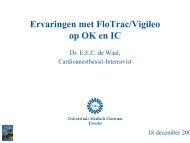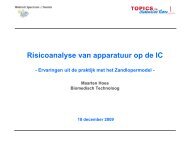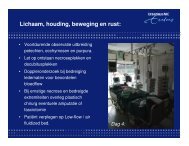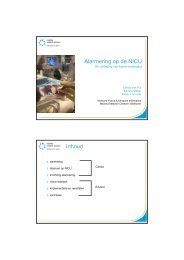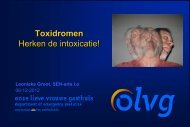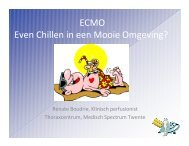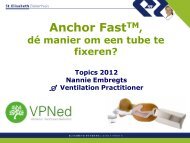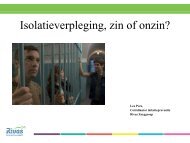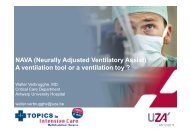Abstract 1 - Topics in Intensive Care
Abstract 1 - Topics in Intensive Care
Abstract 1 - Topics in Intensive Care
You also want an ePaper? Increase the reach of your titles
YUMPU automatically turns print PDFs into web optimized ePapers that Google loves.
Evaluation of two pa<strong>in</strong> assessment scores, CPOT and BPS, <strong>in</strong> mechanically<br />
ventilated patients.<br />
Rijkenberg S 1 , Stilma W 1 , Oudemans-van Straaten H.M 1 .<br />
1 Department of <strong>Intensive</strong> <strong>Care</strong> OLVG, Amsterdam, The Netherlands<br />
Background: <strong>Intensive</strong> care (IC) patients frequently experience pa<strong>in</strong> and agitation.<br />
Systematic evaluation of the level of pa<strong>in</strong> and agitation, followed by a medical<br />
<strong>in</strong>tervention may decrease of pa<strong>in</strong> and agitation, duration of sedation, duration of<br />
mechanical ventilation an nosocomial <strong>in</strong>fections (1). However, assessment of pa<strong>in</strong> <strong>in</strong><br />
ICU patients is a challenge. A patient’s self-report of pa<strong>in</strong> is the most valid measure, but<br />
IC patients are often unable to communicate effectively. The Critical-<strong>Care</strong> Pa<strong>in</strong><br />
Observation Tool (CPOT) and Behavioral Pa<strong>in</strong> Scale (BPS) are validated pa<strong>in</strong><br />
assessment tools for unconscious and sedated ICU patients (2). The aim of this study<br />
was to assess and compare the <strong>in</strong>terrater reliability, discrim<strong>in</strong>ative validity and feasibility<br />
of the CPOT and the BPS, <strong>in</strong> <strong>in</strong>tubated patients on a medical/surgical ICU.<br />
Methods: We performed a prospective observational cohort study <strong>in</strong> a 24-bed level III<br />
medical/surgical ICU <strong>in</strong> a teach<strong>in</strong>g hospital <strong>in</strong> Amsterdam, The Netherlands. Inclusion<br />
criteria were: (1) ≥ 18 years, (2) an expected length of stay (LOS) on the ICU of ≥12<br />
hours, (3) mechanically ventilation, (4) unable to self-report pa<strong>in</strong>. Exclusion criteria were<br />
quadriplegia or paralysis, severe critical illness (poly)neuropathy, muscle relaxation and<br />
contra-<strong>in</strong>dication to be turned. Two nurses performed the assessments simultaneously<br />
but <strong>in</strong>dependently of each other, before and dur<strong>in</strong>g 2 standardized procedures: a nonnociceptive<br />
procedure (mouth care) and a nociceptive procedure (turn<strong>in</strong>g) (3). They<br />
performed all assessments at the same day with<strong>in</strong> 6 hours. We <strong>in</strong>vestigated the<br />
feasibility and workload of the BPS and CPOT with an evaluation questionnaire. To<br />
assess the degree of agreement between the scores, we used the <strong>in</strong>traclass correlation<br />
coefficient (ICC) and to assess the discrim<strong>in</strong>ative validity of the scores, we used the<br />
Wilcoxon Signed Rank test.<br />
Results: Between the 17 th of May and the first of October 2010, a total of 277 noncardiothoracic<br />
patients were admitted to the ICU. The nurses screened 245 (88.4%) of<br />
the patients for eligibility. 123 (44.7%) patients met the <strong>in</strong>clusion criteria and were<br />
<strong>in</strong>cluded <strong>in</strong> the study. The data of 68 (24.5%) patients were complete and suitable for the<br />
statistical analysis. The ICC’s of all the assessments (N=544) with the BPS and CPOT<br />
showed a fair to good agreement, 0.74 95% CI[0.68-0.79] p



